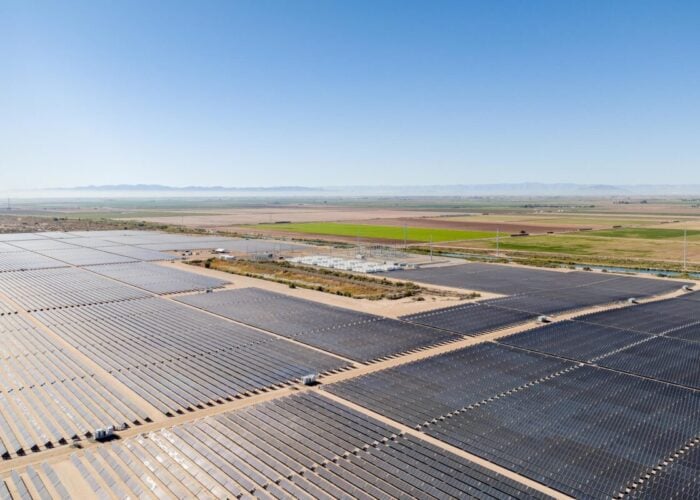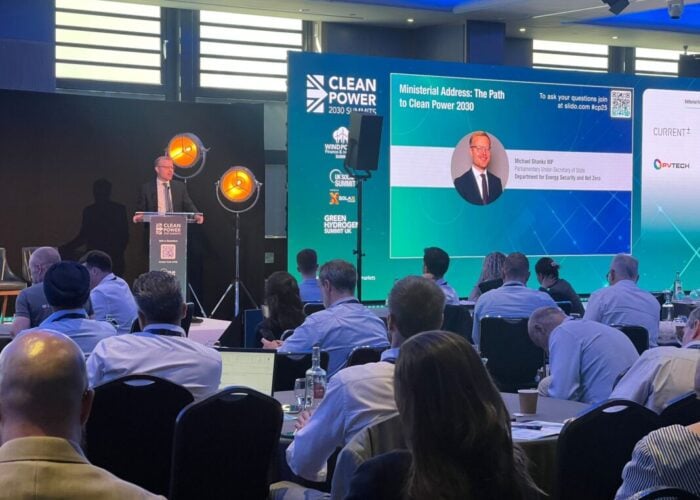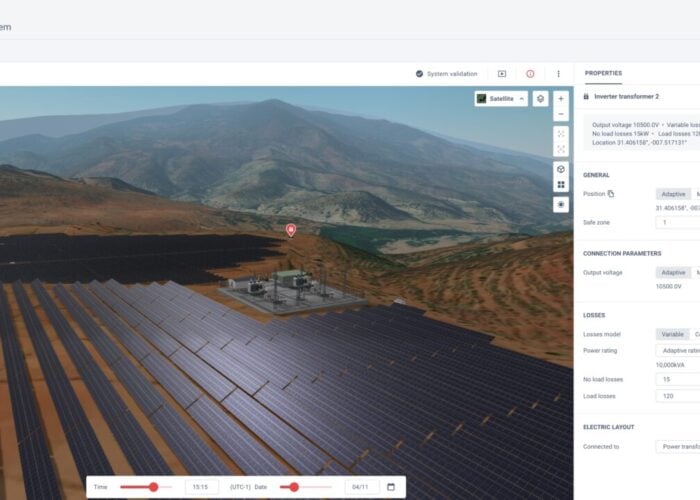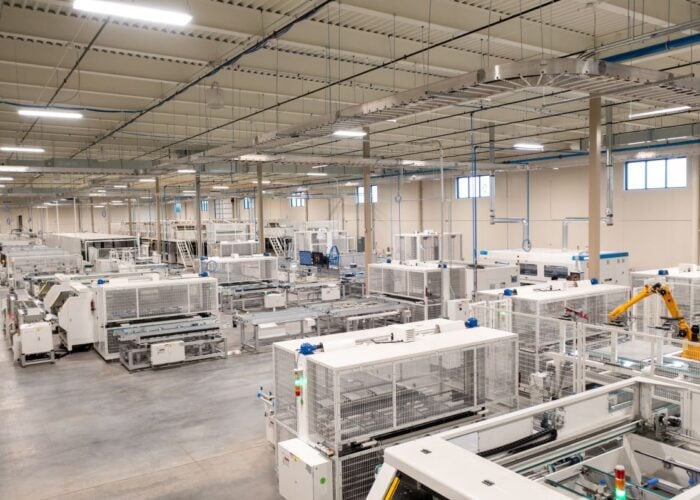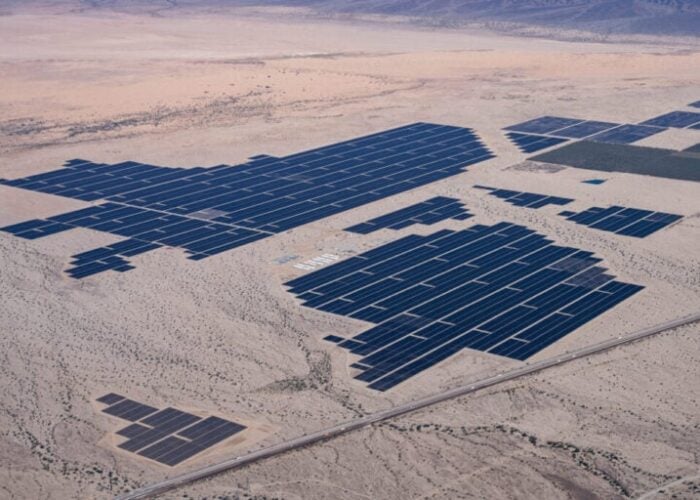
The global solar sector is one of constant innovation and technical optimisation, from the size and scope of modules to the conversion efficiency of individual cells. Another area where the PV power plant business has gone through several evolutionary steps is the voltage of utility-scale systems, which has increased in step with the industry’s ambitions to increase efficiency and reduce costs. Now, just as 1,500V systems have largely become the industry standard, another upheaval looks imminent.
“We saw it jump to 1,000 volts, it then has gone to 1,500V and we’re now right on the precipice of another change, so it’s exciting for me to be part of this,” explains Brian Nelson, renewables segment leader at engineering firm ABB, who spoke to PV Tech Premium about the transition to higher voltages in the solar sector.
Unlock unlimited access for 12 whole months of distinctive global analysis
Photovoltaics International is now included.
- Regular insight and analysis of the industry’s biggest developments
- In-depth interviews with the industry’s leading figures
- Unlimited digital access to the PV Tech Power journal catalogue
- Unlimited digital access to the Photovoltaics International journal catalogue
- Access to more than 1,000 technical papers
- Discounts on Solar Media’s portfolio of events, in-person and virtual
Nelson suggests that the logical next step of this transition will be the deployment of modules and components of 2,000V, and other companies are already pushing at the 2,000V barrier. In May 2024 JinkoSolar received certification to sell its first 2,000V module in the US and in September 2024, GE Verona launched a 2,000V inverter for use in utility-scale projects.
While delivering on this transition will be a challenge – not least because of the need to tailor inverters, modules, grid infrastructure and all other electrical transmission components to the new scope of operations – Nelson is optimistic that with support from across the industry, the solar sector can deliver on this change.
“There are three things you need,” he says. “A module that’s capable of 2,000V, a combiner box that’s capable of 2,000V and an inverter that’s capable of receiving 2,000V. We’re there, so really, now, it’s a matter of how quickly this will all be adopted.”
The business case
When asked about some of the reasons for this transition, Nelson suggests that, as is often the case in the solar industry, pushing efficiency and minimising costs are key motivating factors.
“It comes down to greater efficiency of the system, which yields cost savings to the folks that are developing these projects,” says Nelson. “They’re able to build out their projects at a lower capex and opex, because as you go up in system voltage … your power goes up and your current can actually come down – power equals current times voltage, it’s that equation – so that does a tremendous amount for the system.
“It will reduce your balance of system costs because you can use smaller conductors, while maintaining the same amount of power; and you can start to eliminate things from the system [for example] inverters. Instead of ten [inverters] you may need eight, so obviously that costs you less money upfront, and then there are less inverters to maintain, and it’s the same thing for combiner boxes too.”
Nelson’s comments come as the levelised cost of electricity (LCOE) for solar systems reaches new lows. Figures from Wood Mackenzie suggest that the average LCOE in the North American solar sector fell by 4.6% compared to 2023, while Latin America saw an 8% year-on-year drop and the Middle East and Africa saw LCO fall by 13%.
“LCOE [is] something that I spend a lot of time looking at. If you look at the cost of solar over the last 15 years, it’s been on this downward trajectory,” says Nelson. “The LCOE for solar continues to come down, which makes it competitive with natural gas and wind and other things, which is really exciting. My prediction is that by the end of this year, 2,000V will be the standard in the industry, but that could push off into 2026 as well.”
Distributed solar to remain around 1,000V
However, Nelson suggests the transition to higher voltages will take place at different speeds in different parts of the solar industry.
“For 1,000-2,000V, we’re talking about grid-scale, big solar,” explains Nelson. “As we get to more commercial and industrial (C&I) applications, there’s a shift happening there as well. The C&I side is using primarily string inverters, so that AC to DC [conversion] is happening way closer to the modules, and so then the collection is happening in AC.
“We’re seeing the same thing happen as we see the voltage increase on the DC side; the string inverter original equipment manufacturers (OEMs) are capable of increasing their voltage as well on the AC side. As the DC goes up, the AC goes up as well.”
Nelson adds that he expects C&I projects – with a capacity of around 1-5MW – to see voltages in the ballpark of 800-1,000V, and that the residential sector will be “a step lower” still. However, instead of suggesting that distributed solar is somehow lagging behind utility-scale, he instead argues that this difference in the pace of voltage growth means distributed projects will be able to follow in the footsteps of the utility-scale sector.
“I definitely think the utility-scale sector is really pushing forward and bringing everything along with it,” Nelson argues. “Not to say that there are not really cool things happening in the C&I space or the residential space, because there are, but as we’re talking about voltages and some of the technical details that we have to figure out as a component supplier, those benefits can find their way down into the sub-sectors of solar.”
Technical and human challenges
When asked about some of the challenges involved in delivering this 2,000V transition, Nelson suggested that these “technical details” are among the most pressing, especially for a company like ABB that will have to invest in the design and manufacture of new components, and overcome all of the obstacles associated with such a shift.
“There are only a couple of module manufacturers that are capable of 2,000V; there are only a couple of combiner box OEMs that are capable of 2,000V; same for inverters,” Nelson says, suggesting that making the leap straight to 2,000V could prove too challenging, at least in the short term. “If you go to 1,500V, you’ve got a bunch of options, [regarding] the availability of products to complete a system.”
Nelson also suggests that hiring workers skilled in such an emerging technology as a high-voltage component could be a challenge, as the speed of technological innovation outpaces training courses and qualification programmes. This echoes a sentiment expressed by Andrew Eldred, chief operating officer of the Electrical Contractors’ Association, who told PV Tech Premium earlier this year that the demand for skilled electricians is significantly higher than the supply in Europe.
“[Hiring] is a concern of mine and many in the industry, that the workforce to commission these sites needs to grow, if we’re going to deploy as much solar as possible,” Nelson says.
Nelson also points to the need for standards and certifications to keep pace with technological innovation, pointing to an example of ABB moving more quickly than the Underwriters’ Laboratories (UL) with regard to a switch developed for use in 2,000V systems.
“When ABB had developed a switch that was used in a DC combiner, to get to 2,000V, we were really waiting on UL to develop a standard, so we could test to that standard so we could stamp it and give the industry certainty that the device is capable of that voltage,” Nelson says. “We’re starting to get that as well, the standards are starting to pick up, so the stars are aligning here.”
Beyond 2,000V
Nelson suggests that the solar industry should not and will not be satisfied with breaking the 2,000V threshold, saying “people are already thinking about what’s next”, despite concerns that pushing to even higher voltages will drag the solar industry into the medium-voltage space.
“Will we get to a point where the component cost or the OEM cost gets too high?” he asks. “It’s possible. I can definitely see some friction as we get up there, as we go into a medium-voltage space. With medium-voltage comes more potential risks for personnel [and] there are more complex systems.
“One of the things that ABB does very well is breakers and devices for the rail industry, and the rail industry operates at a really high DC voltage,” Nelson adds, suggesting that even a seamless transition to higher voltages would bring about a transition to a fundamentally different kind of electrical system. “Those components – holy cow! – if you open a combiner box there’s a switch and fuses, but it doesn’t look ‘industrial’; if you look at a 3,000V DC breaker, that thing looks industrial.”
However, Nelson also suggests that these concerns are no reason to shy away from investing in higher voltages because, as he puts it, the world could move to a more DC-led power system.
“This whole voltage shift that we’re going through is a peek into a market where we’re starting to see ‘emerging DC’,” he says. “DC as an ecosystem is going to be an important future opportunity globally. We live in an AC world [but] can we live in a DC world?
“I’m really bullish on the opportunity for DC to be more of a part of our world, and I think the developments there at the solar farms and the increased voltages there are doing a lot to prove that higher voltages are possible, and we have the components to support it.”

